
[ Home | Staff & Contacts | HiFi Playground | Listening tests | DIY & Tweakings | Music & Books ]
Visitor: Carlo Iaccarino
The show took place May 14th to 17th, 2015 in M.O.C., Munich/Germany
Report: May - August, 2015
Website with lots of information High End Society.de
Here are further exhibitors that fascinated me.
DIGIBIT area
This spanish company exhibited some audio servers with original playing/archiving software. Two models are proposed. The Aria Mini is more lifestyle, is an i-Pad dedicated model and costs about € 3.000; istead, the big Aria is a classic tabletop model, costs about € 5.000 and sports better DAC and audio circuit board than the Mini. Both models can stream their content toward other "zones" in your domestic network and can be commanded via an i-Pad. For me, the Mini is much cuter. A long time consulent of Digibit is our engeneer Marco Manunta, but not - as I naively immediately thought - for the "DAC side" of their gear; he is of counsels for their "audio side" and for the software that manages them.
Many of the exhibiting companies are the brainchild of one, sometimes unique, person; for Digibit, it is the nice boss, Samuel Perez, here pictured near his creations (the Mini is the... smaller one).

DEVIALET rooms
Also this year this innovative (former) French start-up, put up a big demonstration of strenght. They set up a room dedicated to Phantom, their device that blends the usual - for them - sophisticated electronics for device management and signal amplification, with an innovative fullrange (response specified from 16 to 25.000 Hz) loudspeaker system. All remotely commandable, configurable in how many channels you want, as well as being very powerful, very stylish, etc. Moreover, they set up a more traditional - although this is not the term I'd use to describe this company's products - room where multiple Devialet power amplifiers were geared up to form a system that drove a pair of B&W Nautilus, digitally managing crossover cuts and adaptation to the loudspeaker's electrical characteristics - their S.A.M. system (for which I once again point you to my article on last year's show...).
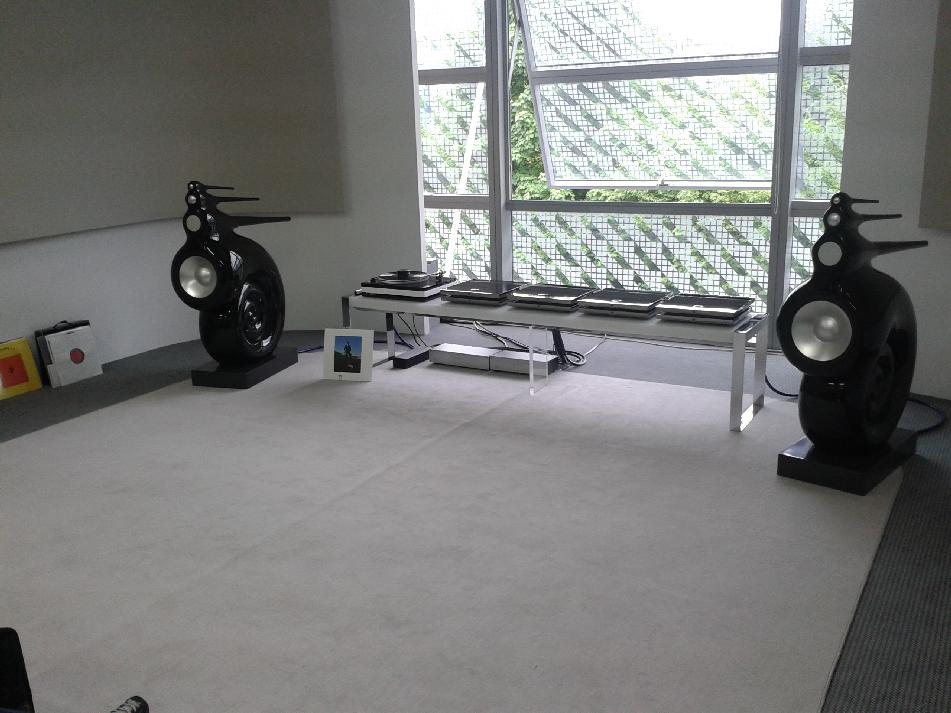
NAIM-FOCAL rooms
Unfortunately, this year I couldn't attend the press presentation of the group's news, because it overlapped with the MQA talks (of which I wrote in the first part) that I followed until the very end - my hopes for a British alliance were unfulfilled :-)
Anyway, this year's news were the introduction of the Sopra loudspeaker line by Focal.
For now, the series comprises a floorstander, the Sopra n.2, at about € 12.000 and a stand-mounted model, the Sopra n.1, for about € 8.000.

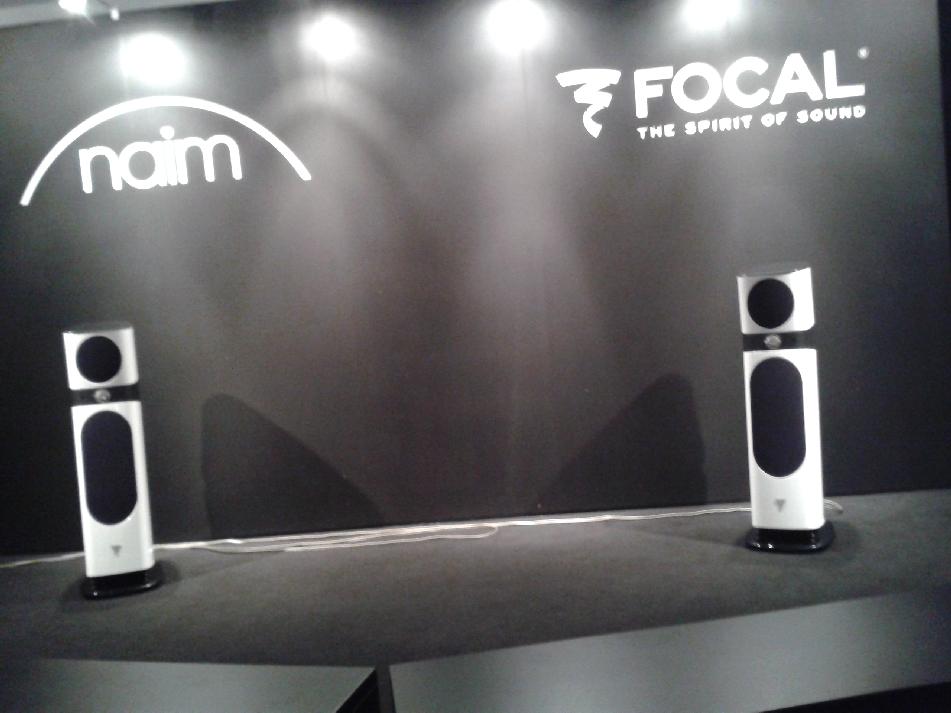
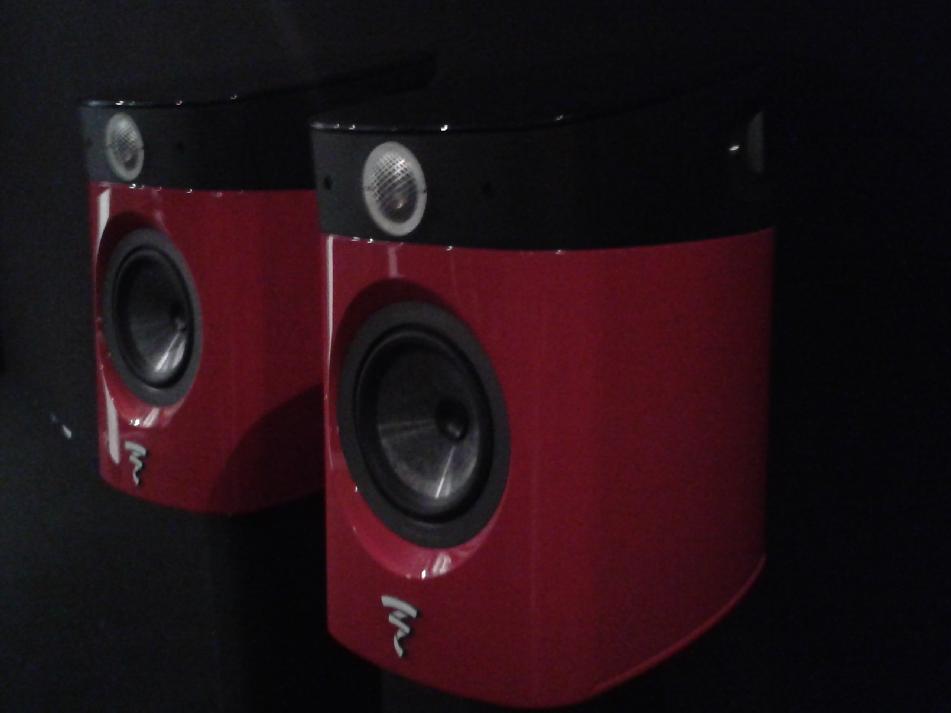
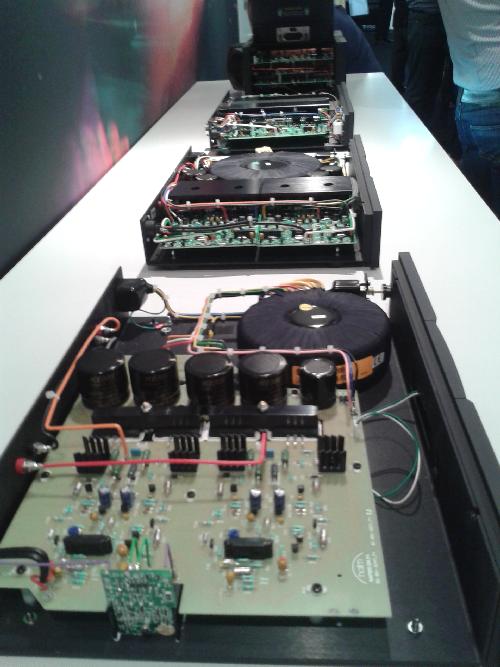
Q-ACOUSTICS room
I want to pay the due respect to this company, proudly British and maker of loudspeakers, and IMHO very well sounding and, looking at their general competitors, also very affordable. In a big room they exhibited their models, and a completely "normal" system to which they hooked up - alternatively - the 3050 floorstanders (for a price varying from € 758 to € 998 per pair, depending on the veneers), and the 3020 bookshelf (for a price varying from € 318 to € 398 per pair, depending on the veneers). I thought they looked nice, well crafted and neutral in respect to the common domestic room in which they will likely be placed. My listening was always very pleasant, surely amazing for the price; probably a good contribution was also provided by the energy with which the demo was performed by the company's people.
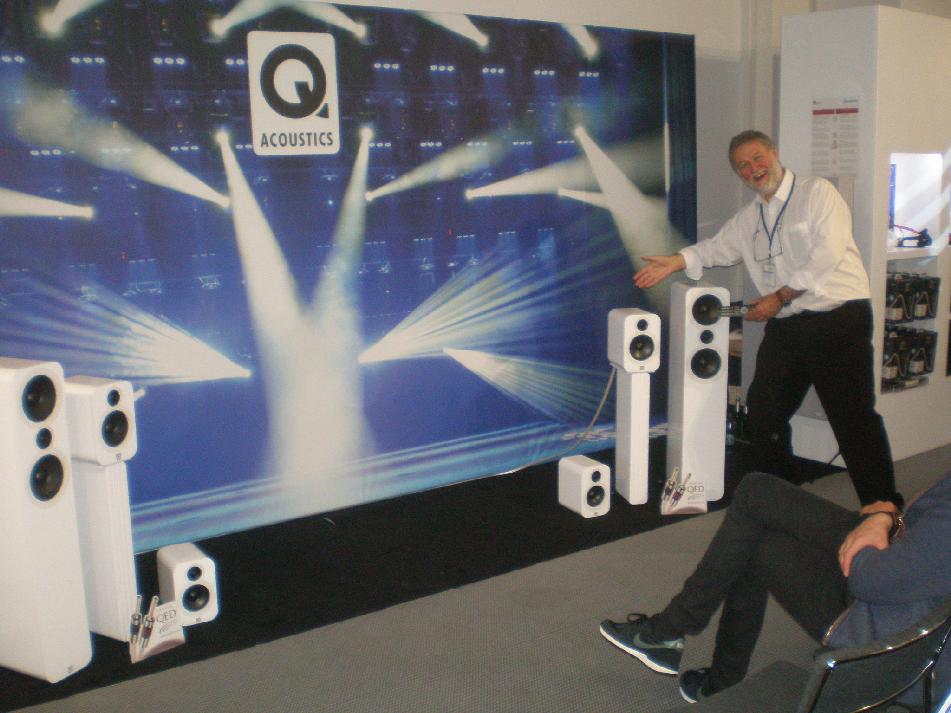
CAD-BOENICKE room
Here a system was playing made up with devices completely new to me.
The digital source was provided by CAD, one more company created by the passion of a single man (Mr. Scott Berry, if I didn't mis-scribble my notes...), but also managed by his lovely and very feet-on-the-ground spouse, Isabel, whose neverending and hard management work allows him to play with his toys :-)
CAD makes a two-device source. One is the CAT, both a transport able to rip discs in its internal memory and a network player/streamer, naturally remote commandable by a smart device, even a smart TV. The other is the 1543 DAC, a converter that, intuitively, is based upon a Philips TDA 1543 chip, one of the last few chips that sports the so-called "resistor ladder" (i.e. performs a multibit converson) and that doesn't apply any oversampling (belonging to the NOS/ZOS school). A fact that, for some, leads to the best digital listening experience possible. Moreover, CAD worked on the USB interface, galvanically insulated and with a circuit board specifically designed and developed ad hoc. They are devices produced in little bunches and for very specific tastes; consequently they are not sold at a "popular" price: GBP 5.300 for the transport and GBP 7.250 for the DAC (20% VAT included). For about € 18.000 you bring home a digital source open to the new solutions (streaming, home network) and, at the same time, stuck on a very traditionalist vision of domestic digital audio. Isabel told me they are looking for distributors, also for Italy (as a good Brit, she hoped for someone based in beautiful Tuscany or in the southern seas...): they'll update their website with every related news.
At the system's opposite end were hooked loudspeakers by BOENICKE AUDIO, the W8 model, floorstanders. Small, elegant, refined, sporting a particular inner machining; although not big, they succeded in filling the room, going very low in frequency and loosing nothing in definition and clarity. This company makes also a smaller model, the W5, a floorstander (don't ever think to dare place it on a bookshelf...). Also with this company, maybe due to it being based in Switzerland, prices are fairly expensive: the W8 starts from € 5.900/pair, and the W5 starts from € 3.500/pair; smarter veneers require an extra charge....
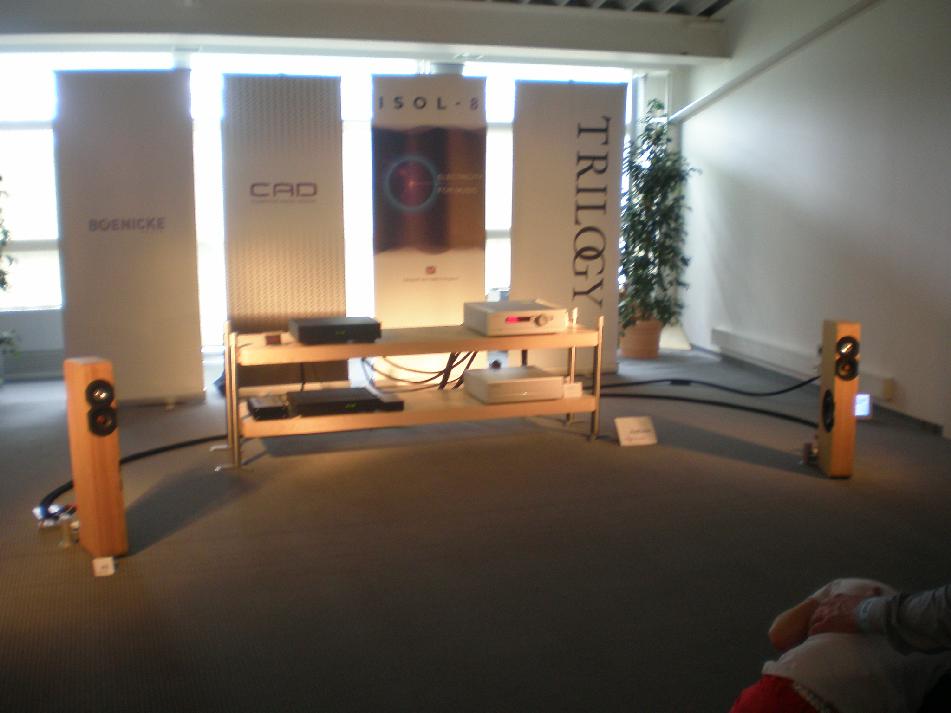
FURUTECH/ALPHA Space
In its usual space in one of the Hall at ground floor, Furutech/ADL exhibited lots of beautiful things. Among them, I was attracted by the ADL Stratos, a preamplifier, sporting an MM/MC phono input, a can amp, a converter A/D (PCM up to 192 kHz / 24 bit) and D/A (PCM up to 384 kHz / 24 bit; DSD up to 5,6 M) with an XMos-based USB interface, using as chip DAC the ubiquitous ESS Sabre ES9018; it's scheduled to hit the shelves not before one year, at a predicted price of € 1.000. It is a definite upgrade from the already very good ADL GT40, now offered at € 450, and of which lots of good reviews can be read. Here we go with a close-up, waiting to hear it play in some illuminated shop...

HARMAN INTERNATIONAL Room
Here, in the same space, two systems were assembled, both with Mark Levinson electronics. The big one sported amplification via a preamplifier + two mono power amplifiers and drove a couple of wonderful JBL Everest 6700, with the usual powerful and authoritative sound usual for this combo.

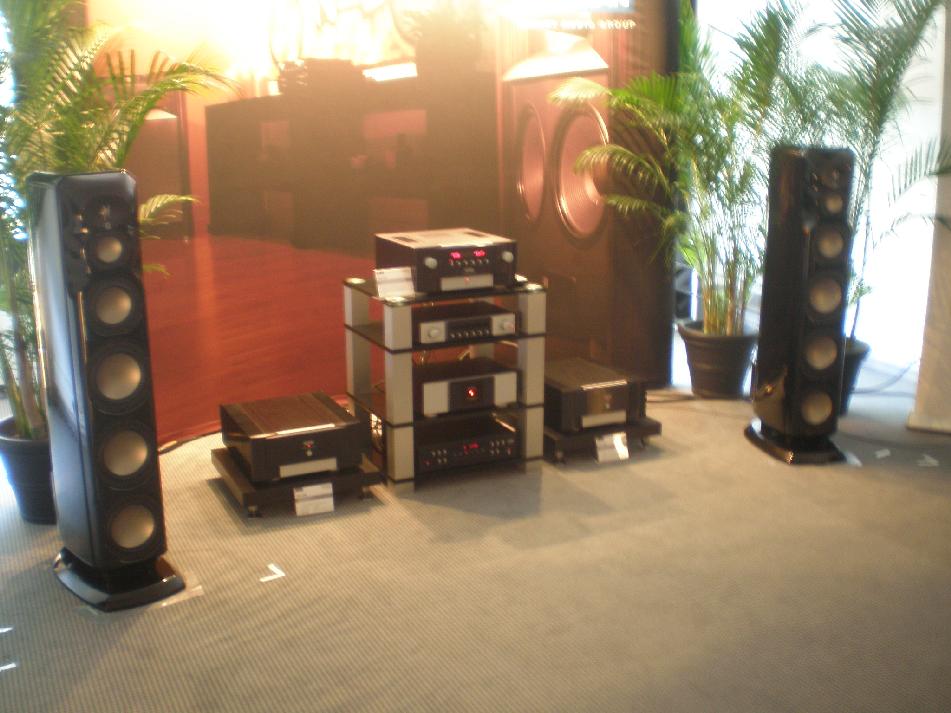
TOTEM ACOUSTICS room
This Canadian company's room was essenntially identical to last year's, and it gave me a conforting sign of continuity and helped very much to fix the memories in the mind, something always difficult in such a huge show. The landlord was again the affable Vince Bruzzese, and his demo kept the kind and effective style I described in last year's article. This year I listened to the demo of their Tribe V model, that was exhibited as a floorstander, but that is conceived, as far as I understood, to be mounted in-wall, and it is made also in a version that allows such an "architectonic" installation.
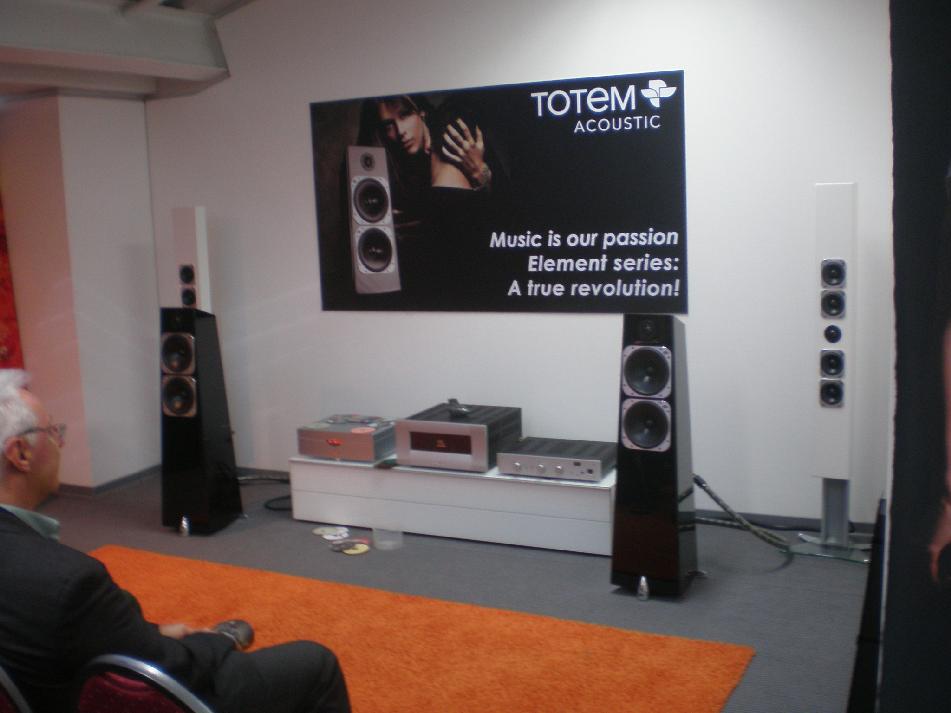
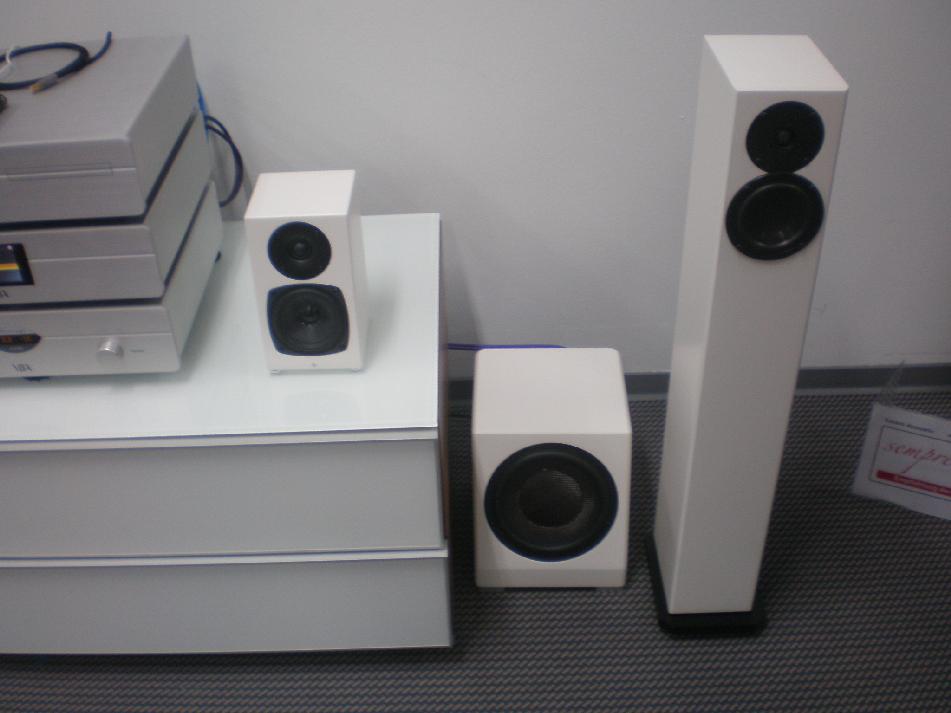
LAB 12 space
As I already wrote, at this huge show you can also see that often behind these brands you actually find not only big companies, but also, more often than not, single enthusiasts that take care of their entire business. It's the case, also, of LAB 12, that produces tube amplifications whose look is well finished and utilitarian and, so they say, sporting uncommon circuit ideas. Among their products there is also a power conditioner/distributor, aptly named "Gordian", and a NOS DAC built with a parallel of eight Philips TDA 1543 chips. Their products bear a real-world (well... our insane world) price tag showing clearly their effort to sell affordable things. Their most expensive device is the € 3.284 "integre4" integrated amplifier, and their cheapest one is the € 1.168 above mentioned Gordian (all prices VAT included...).
Here are, then, the bold and young guys that hide behind the LAB 12 moniker
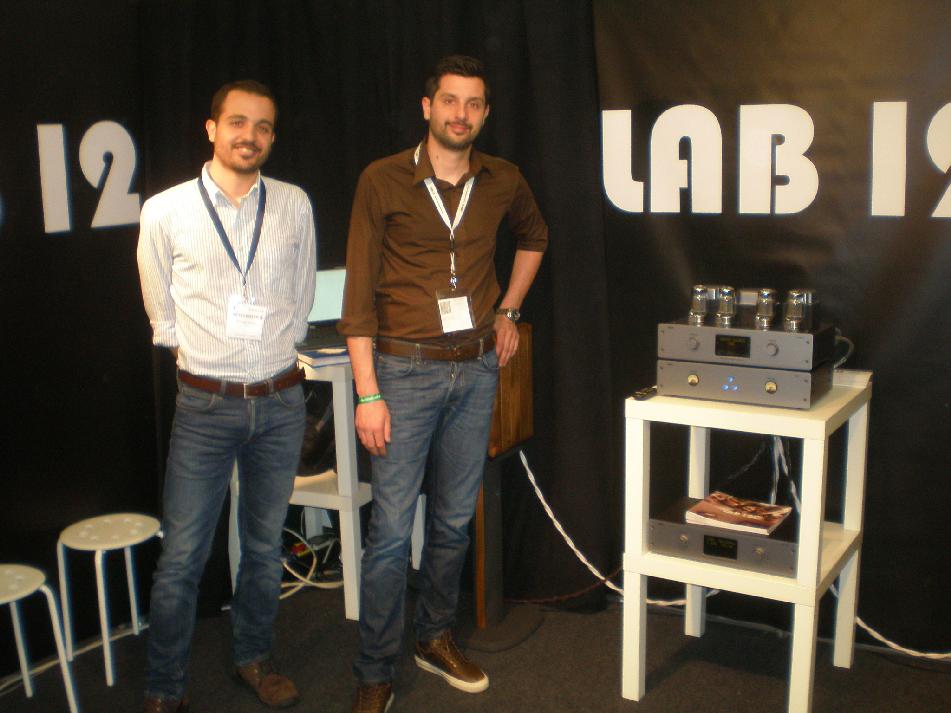
QUESTYLE space
Hanging around one of the big Hall at ground floor, I met this USA brand, a very technological company, that produces DACs, also portable ones, and dedicated to headphone amplification, very well reviewed. But I was attracted by their system (that reminds me a little of the Digibit Wamp described above, but with a different technology) made of the circa € 1.000 T2, a digital signal wireless transmitter/processor and two € 1.000 each R200s, 200W digital (ICEPower) monophonic amplfiers sporting a wireless receiver/DAC module; it's also available in a version sporting a 50W/ch stereo amplifier, again with an ICEPower module. This system permits you to wirelessly (5 GHz) transmit an uncompressed digital signal up to 22 MHz / 24 bit. It all comes in a travel package.

RADSONE space
This company from Korea set up a little space (alas, with respect to the show's huge proportions) where their airDAC was exhibited. It's a DAC (this time, based upon the BB-TI DSD1792A chip) capable of handling high resolution signals, also in DSD (it changes DSD into DOP, following a strategy shared, for example, by... ESS with its Sabre32 chips), plus all other compressed formats. It can connect wirelessly with smartphones, iDevices, etc., or via USB with a PC; it also sports a headphone amplifier; it can read files sent by any device that can download them from a streaming service. All for the American price of USD 1.000. Put it this way, it may be a device like many others, but the difference, in my opinion, lays in the software solutions on which it is based. Try to imagine my difficulties in following an enthusiastic Woo-Suk Lee, Radsone's technical manager, who tried to make me understand this device's peculiarities. Hoping he can forgive my horrible errors, I'd say that this DAC distinguishes itself from the mass basically by two characteristics. The first one is its USB input, capable (it should be the only one in the market) of receiving signals up to 192 kHz; it does not rely on the usual off-the shelf solutions, like the X-Mos receiver or the like, but it uses a Texas/BB receiver chip programmed by a proprietary software. Moreover this USB input is galvanically insulated, and this should intrinsically produce clean digital signal transmission, independent from the dirt it collected along its path. This DAC's second main distinctive characteristic is the DCT software, a DSP that allows for a particular digital signal dithering, performing a digital signal processing that adapts to its content, identifying and eliminating undesired noises and digital artifacts that, according to this company, are always present, also in high resolution signals. My listening was completely unrevealing: I listened to a headpone into a noisy environment; yet, this product looks nice and is fascinating for the unusual solution it sports. It should still be seeking distributors...
LAKE PEOPLE space
This German company - that owes its name to it being based in Konstanz... - shows a packed series of DAC, preamplifiers and headphone amplifiers, all under the Violectric brand. Among the really numerous exposed models, the company's personnel pointed me to two new ones.
The first is their new amplifier for 2 headphones / line preamplifier, with inputs and outputs also in balanced mode, which is proposed in two versions: the HPA V220 model (at € 1.900, 19% german VAT included), that drives the cans in traditional unbalanced mode with two stereo big jack plugs, and the HPA V281 model (€ 1.400, VAT incl.), that drives the cans in balanced mode, with a balanced plug and two mono big jack plugs, one for left channel and the other one for the right channel. Both models can mount a DAC module (for € 200 more) and their volume control can be also made with a remote controlled motorized potentiometer (for € 250 more) or with a remote controlled attenuator made with relay-switched combined resistors (for € 500).
Further new products were their new DACs. The first is the DAC V850 model (€ 1.400, 19% VAT incl.), sporting also balanced outputs and digital inputs, even USB, capable of handling high resolution signals (up to PCM 192 kHz / 24 bit). Ihe input digital signal, no matter what its frequency is, first is oversampled at 32 bits and then can be upsampled at 96 kHz (or according to different factors, user selectable); then it is sent to the chip (this time, two PCM 1795, they, too, working at 32 bits). The DAC has also a volume control, solely performed in the digital domain. The company says that, since the signal is always oversampled at 32 bits, this somehow compensates for the unavoidable resolution loss at high attenuation (necessary for a low playback level). Finally, it can optionally mount a board to remotely command the volume control and the input switch, for further € 250. The second DAC is a reduced version of the first one; its' the DAC V820 (€ 750, 19% VAT incl.), that sports similar features, but the USB input is optional, the oversampling is always at 32 bits, but the upsampling can be set only at 96 kHz, the output volume is fixed, but the gain can be set on four different levels.
The Violectric booth was always very crowded: lots of headphones available for listening, all very appreciated models, and all the cans, even the ones with difficult interface values, were very well driven. They are very well crafted devices; not affordable, for sure, but still accessible, and very far from the worst exaggerations of the High End. Surely the wealth of solutions proposed inscribes Lake People among the companies that believe that the future of audio moved from the couch to the desktop: their devices are aimed at personal listening, much in combination with a PC, connected or not to the web...
THRAX room
The Bulgarian Thrax set up a big room where they showed a system entirely made of their own gear (sources excluded): Orpheus pre phono (€ 16.200), Dionysos preamplifier (€ 16.200), Heros 100 W monoblocks (€ 25.200 the pair) and Lyra standmounting loudspeakers (€ 16.200 the pair - stands € 1.800 the pair). The electronic gear is presented as designs with original solutions, using either vacuum tubes (mainly direct heating triodes), either transistors (MOSFet e JFet), with tricks to reduce the risk of picked up noise (input transformers, disconnection of the ground of the unselected inputs, etc.) and for an effective coupling with the load. They are unquestionably very expensive devices, and I personally think I could never be able to afford them. Yet, among the many crazy things seen at the show - that, after all, is literally entitled to High End... - they, at least, recreated a very pleasant and really involving sound. In other words, one of those cases in which you just want to stay and listen, not worrying about the surrounding problems. Isn't this one of the main benefits of attending such a show? To be exposed to devices normally out of our range and, in this case also out of our possibilities, since the building of their international distribution net is (still?) in progress.
YBA space
This year Yves-Bernard André set up his space in one of the big Halls at ground level like a French Island where its landlord greeted his selected guests with plenty of tricoloured flags, champagne, etc. But, with its distinctive original touch, YBA exchanged the Gallic grandeur with a British understatement. All the models were in silent exhibition, accompanied by their written description, and it was up to the visitor to show his interest in something and, eventually, ask for some information that were then promptly provided. The very cordial brand representative pointed me to two major new devices.
The first one is from the heritage range, the second from bottom in the YBA catalogue, and is the new release of their MP100 SE media streamer (€ 1.900 circa),


BLUE AURA space
Again in a Hall on the ground floor, I met Blue Aura, a proudly British company (in the press folder there were also a little Union Jack...). Also in this case it's a company driven by a real person, Mr. Nick Holland. It produces mainly loudspeakers, set and ready to wirelessly play digital files that can be sent to them either via Bluetooth/NFC, or via a proprietary 2.4 GHz WiFi protocol. All those loudspeakers are active models and use a DSP. They have minimalistic aesthetics, with an evident effort to avoid useless embellishments that only push up the price, which indeed here is limited. Nothwithstanding this fact, all models are well finished, apt to neutrally match the domestic environment, due to their reduced dimensions and the (eco)leather finishing.
I was interested in this brand because I felt that behind the commercial proposal was a thinking mind, always focused on the needs of a normal user of music that wants to easily put sound in his domestic environment. Actually, its solutions belong much to the plug-and-play logic. For instance, there is the WS80i system: for GBP 450 it comes with a pair of active (D-Class TI amplification module) bookshelf loudspeakers, a WiFi transmitter (to plug into an existing source or to a PC via its USB port) serving a distance up to 30 meters, and a remote control. Of course, there are also floorstander loudspeakers, subwoofers, plus all-in-one loudspeakers to connect on the fly to smartphoines, etc.
Lastly, maybe to satisfy the die-hard nostalgic, there's the v30i system that, in a single pack, comprises a remote-controlled 20 w/ch tubed integrated amplifier sporting 2 line inputs (one on 3,5' minijack) and 1 USB input, two little desktop passive two-way loudspeakers with their bases to tilt them backwards, the remote control, interconnects, USB cable, loudspeaker cables, 1 spare tube, cotton gloves and dust removal tool. I don't know about you, but this mindsetting tasted to me much like sane old England... God Save The Queen! :-)
Network DACs, streamers
Of course, there was a real bloom of this kind of gear, that made me think that this is the immediate future, if not the present, of modern music systems. I don't want to hide my embarassment in sailing through this mare magnum of proposals, that I hardly could differentiate, surely due to my incompetence, but also because they are often based upon almost standardized solutions (e.g., the ubiquitous DAC ESS Sabre 9018 or, for the less wealthy, 9016...). So, I'll point you to two solutions that more struck me, maybe also because they were better shown off by their producers.
Merging Technologies, a company very famous in the pro sector due to its solutions for music production studios, was showing the Nadac, a network DAC that, according to what the very competent company manager I spoke with illustrated, is the only one that supports every format (PCM 44.1 - 384 kHz; DXD; DSD 64 - 256), connects to your LAN via an ethernet port using the Ravenna protocol (that should allow for a maximally clean transmission of signals), is capable of managing a network-based system sporting different sources and different zones. It comes in two configurations, depending on its outputs: plain stereo (€ 8.000) or 8-channels (€ 8.900).
Aurender exhibited a crowded range of devices for distributing and reproducing high resolution music files, stored in memory supports either internal (up to 12 TB), or external (NAS), that use a proprietary software to manage the archives (meta tags included) and to command its functions via iPads or the like. New for this year is the full compatibility with Tidal, the online streaming service providing uncompressed CD-quality music. Among the different models I was interested in was the N10 (American price: USD 2.500), that can read files from the internet, from a NAS in the LAN or from the optional internal storage (4 TB - for USD 200 more), to pass the file into a 240 GB SSD that works as its cache memory from wich the file is actually read and sent to one of the - only digital - available outputs (USB and S/PDIF coaxial, optical and AES/EBU on a XLR plug). As you may have guessed, to finally PLAY the music content of the file read from the streamer, you need a DAC and then an amplifier to drive your loudspeakers... or you need an amplifier with an internal DAC, just like the one that (also) Aurender makes: it's the X275 that contains either a DAC (with the ubiquitous ESS Sabre chip), and a 125 W/ch ICE Power stereo digital amplification module, all for an American price of USD 2.500.
Multimedia servers
A little off to the side, almost to avoid underlining their status of outsiders to the pure-audio sector, there were also some companies exhibiting only multimedia servers.
One of them was DMA that showed a device that basically is a PC working on Windows 8 (that, according to the enthusiastic engineer that curated the demo, is a very good tool for treating audiovisual streams) and running a proprietary software in which resides the core of its high-end audio and video processing. Everything is placed inside a little box that can be hidden hung on the back of a flat TV, mounting a transport for reading optical disks and ripping them into a memory (internal or networked). It allows the creation of a domestic cloud, the management of an IPTV system, and other evil tricks. Its basic version, the model DMA-06 costs € 3.600 and is ready to be connected to your network; if you want to make it the heart of a more traditional system, you can add the preamplifier module, for a further € 2.500. Of course, it is completely tailorable according to the customer's specific needs.
Another one was Purist Music-Machine. Again, a little box, in standard rack dimensions, with a (bit too much) professional look, with a slot-in transport for optical disk reading and ripping, also on a network attached storage, with streaming capabilty, and a dedicated app for the GUI to remote control all its function, etc. All comes for about € 7.000, in the version that includes also a DAC module.
I repeat, my intention was not to write an official report, done better by professional reporters, who are more competent and educated than me. Yet, I can see that I wrote a lot and I still have a great deal of information I'd like to pass on to you that was available in such a huge exibition.
So, I'd better put here in no order at all some further thoughts and some of the pictures from this year, as I wrote in my foreword, I tried to shoot and that now I put here in a final roll, to satisfy your (our) sane voyeuristic desire.
Let's start with a couple that was the buzz of the day: the Dragonfly little USB DAC / headphone amplifier (but it can also drive line inputs, like the ones you find on integrated amplifiers or on active monitors...) and the Nighthawk headphones

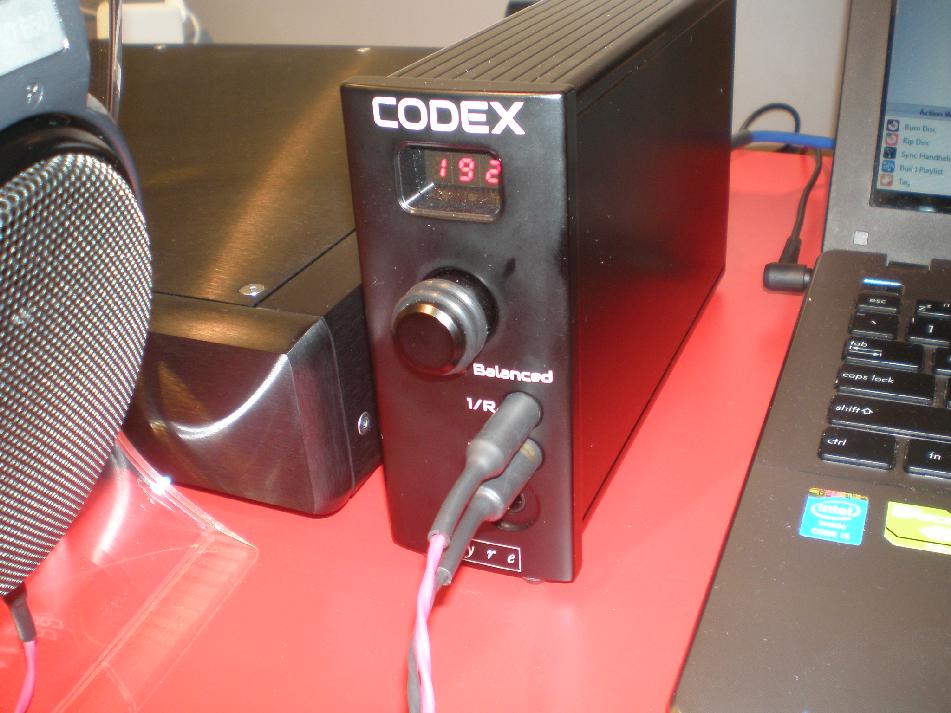
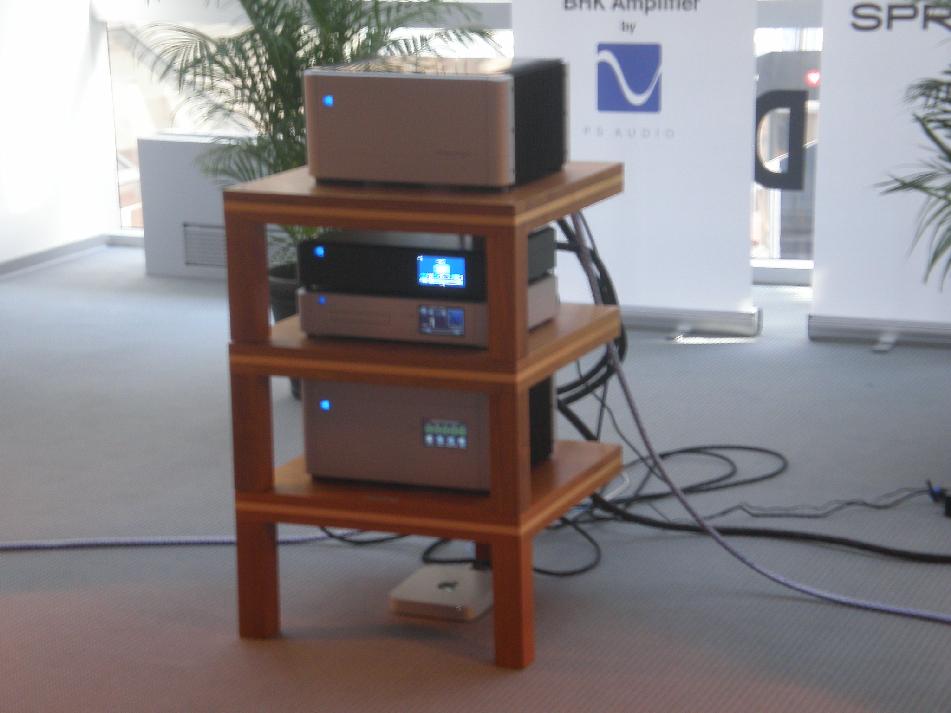
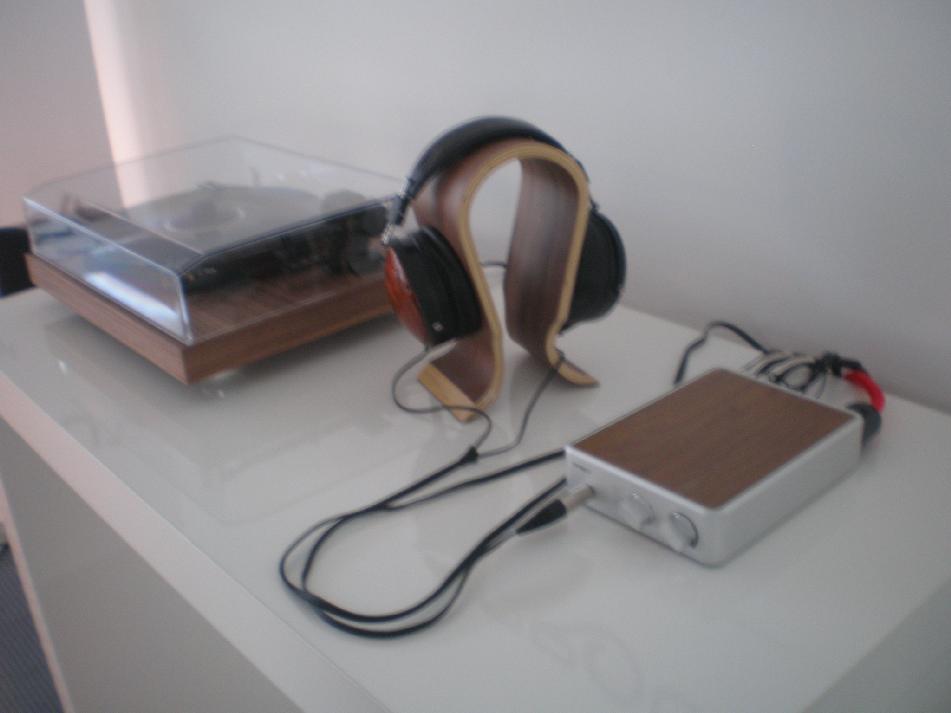
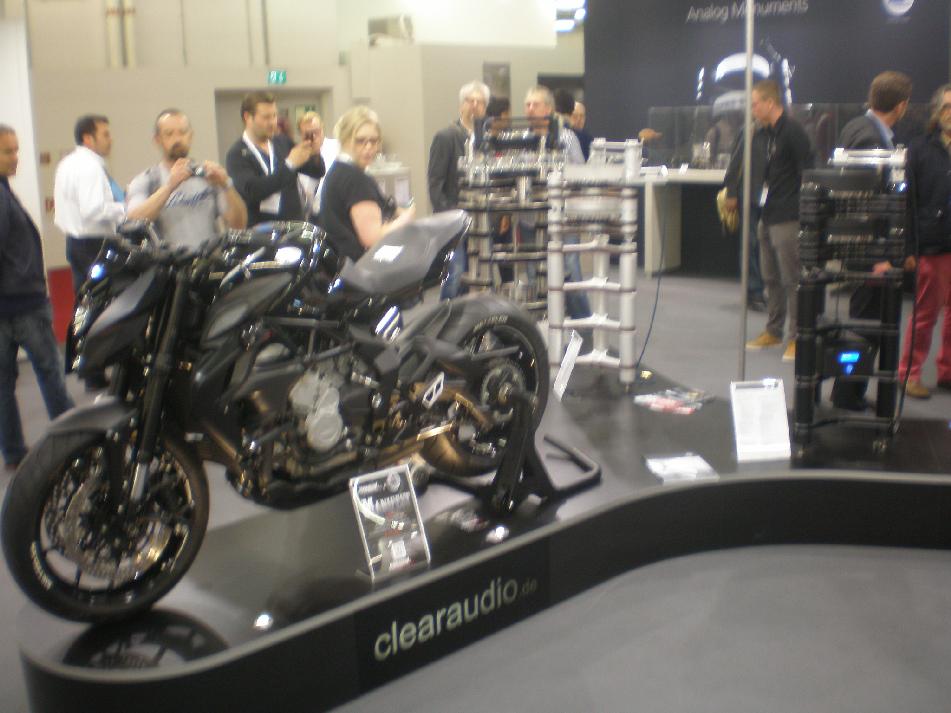

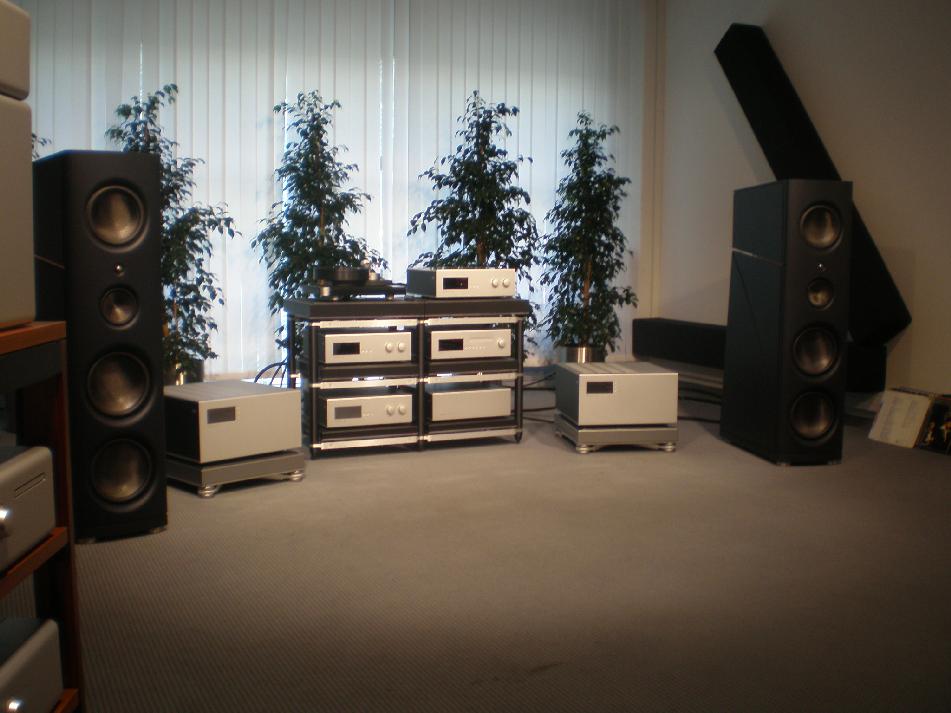
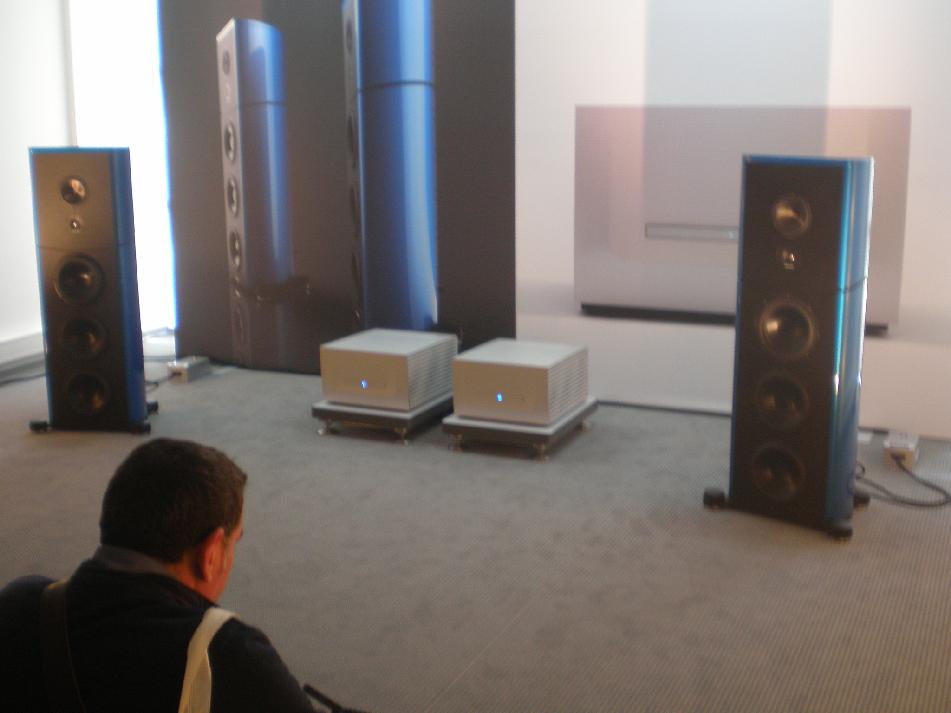

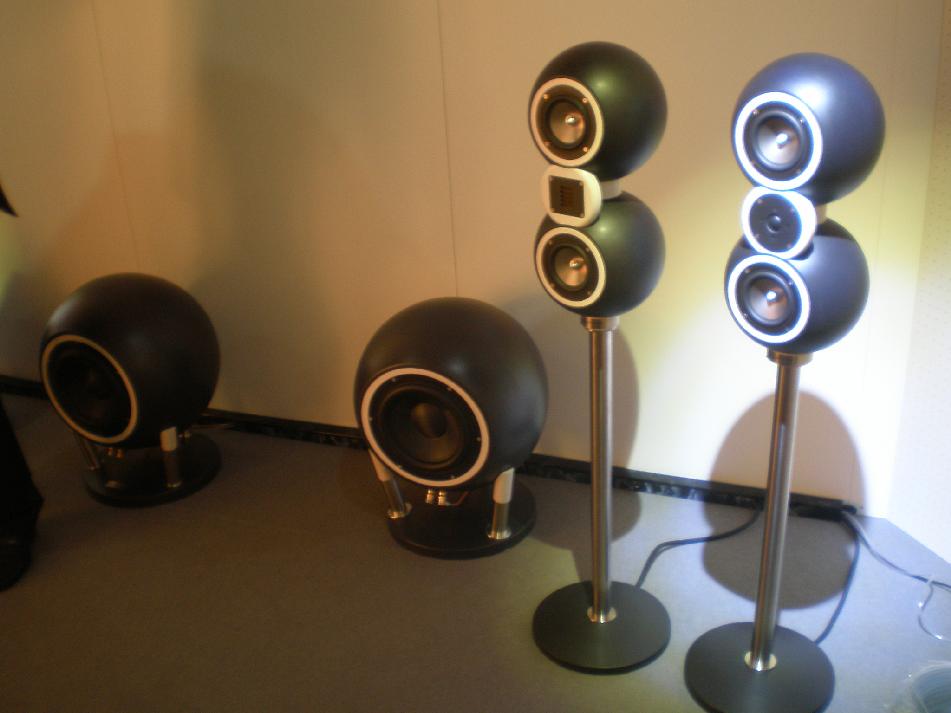
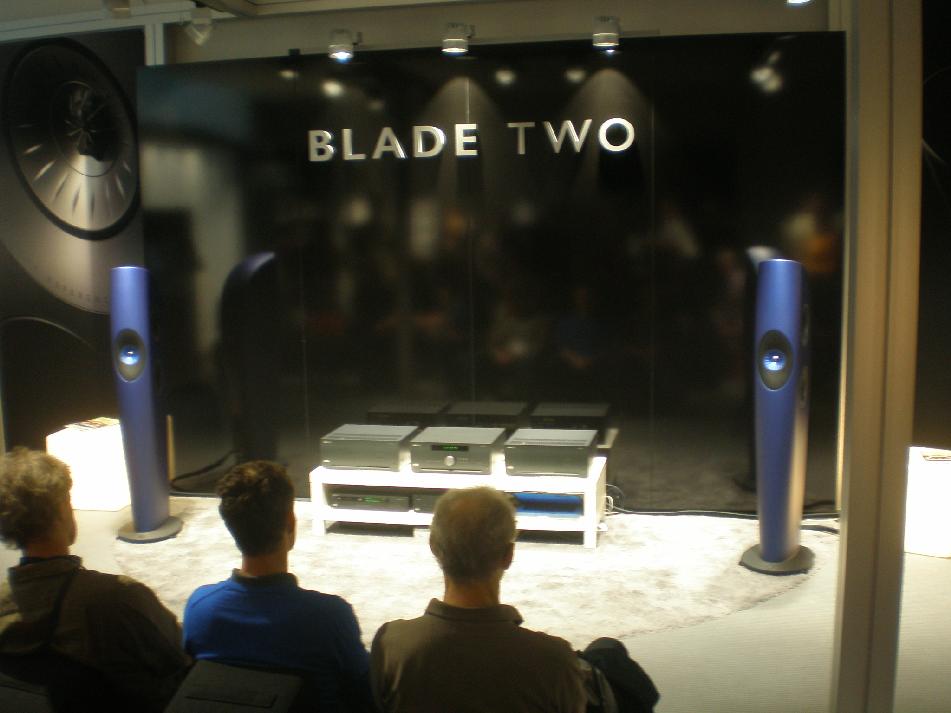
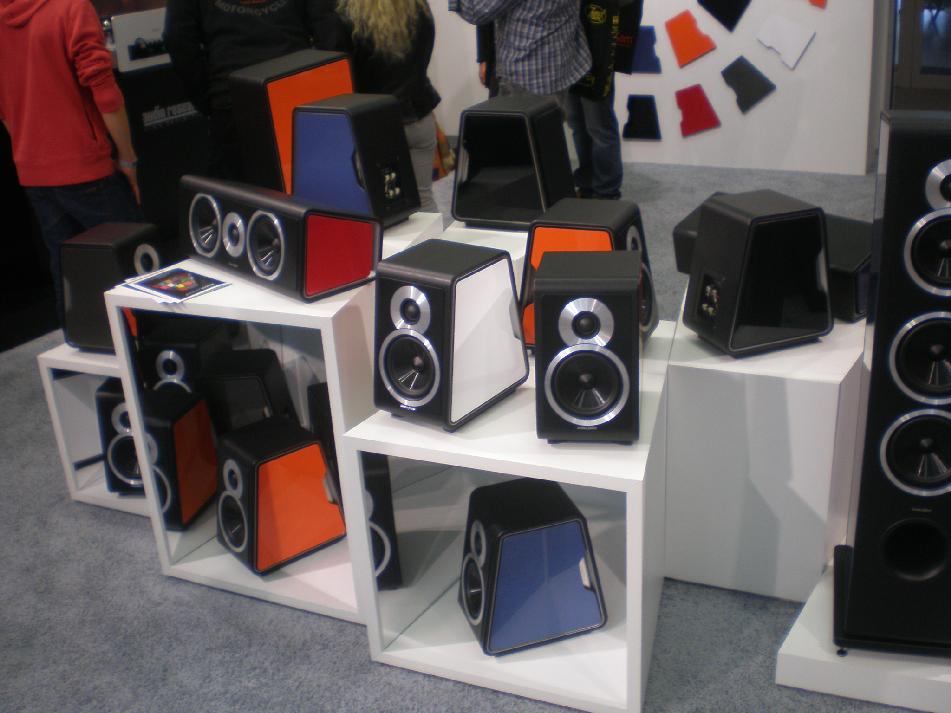
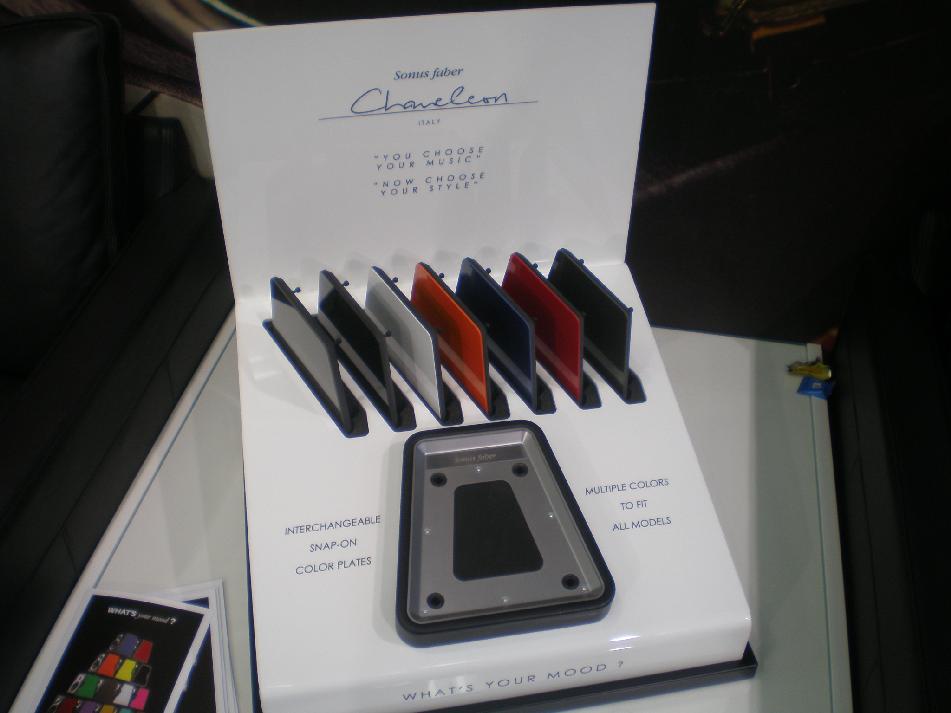
Let me quickly go to the first that was immediately evident to me, since my first flipping through the Exhibitors' list: MCINTOSH IS MISSING! The absence of the iconic-brand of this entire sector is already enough to leave me puzzled, but what surprised me more was its absence among the brands of its powerful German distributor, Audio Reference, who, still, keeps on carrying all the brands belonging to the Fine Sounds group - I don't know how much of this is due to the management buyout by Randall and Grange: in the Fine Sounds group McIntosh is still present... Once again, I point you to my 2014 show article, where I raved about this same distributor's setting, in the same big spaces, with an impressive power demonstration made with a massive presence of the blu-eyed amplifiers. Instead, this year it set up a surely wide exhibition, but less imposing, which didn't allow me to perceive the beauty and the luxury behind its products that I recall from last year (then, mainly Sonus Faber, now much less evidentiated). Moreover, the same distributor exhibited some amplifiers both by Krell and by D'Agostino, again leaving me somewhat puzzled. Anyway, on show there also were the new and coveted amplifiers by Wadia and Audio Research.
PIONEER had a nice room, not overly big, where it demoed it new products; in particular, the BDP-LX 88 disk player, a kind of anti-oppo (multistandard, Hi-Res, 4 K, ESS Sabre, etc.), and the U-05-S DAC/pre/headphone amplifier (Sabre also here, balanced outputs, powerful amplification, etc.). In another part of the room, this company set up also a playing system, with one of its network players, and voiced by two good Dynaudio loudspeakers. That surprised me, because Pioneer makes also loudspeakers, either cheap (some even well reviewed in magazines), or more expensive, a direct consequence of the work of TAD, and very well sounding. I don't know how much this was influenced by the move of TAD's designer, who joined German loudspeaker maker Elac (news of which I could read only in press alerts after the show...).
Well, I must admit that also this second part ended up being massive. Yet, I didn't mention lots of other things.
GRIMM AUDIO, with its LS 1, a very sophisticated active loudspeaker that, in its base, can also include a subwoofer, and that sounded really nice. But it did have the downside of being a tad pricey (€ 25.000), althought it must be said that it's a device that incorporates half system: just add a source and it plays......
DS-W1 Nightrider phono cartridge, by DS AUDIO, that doesn't sport a magnetic motor, but an optical one: a LED shots its infrared light beam against a light-sensible diode and in the middle of the light path there's a screen connected to the cantilever that, in turn, modulates the infrared light beam. The diode sensor converts these modulated light pulses into an electric signal that drives a proprietary pre-phono. All really fascinating but also very expensive: € 8.800...
Ralf Koenen's PROGRESSIVE AUDIO (once again, a company that substantially identifies itself with a person in flesh and bones), proposed both amplfiers based upon new and efficient transitors, some Silicon Carbide FETs, again very expensive (starting from around € 10.000), andloudspeakers, again completely homemade built around drivers by Accuton and Seas. I listened to the Extreme III (€ 8.000 circa) and it made a very good impression on me.
WISS AUDIO, whose devoted marketing manager, Murray Kun, notwithstanding the language barrier, illustrated to me the very wide range of little devices this company produces: DACs, DAC with headphone amplifiers, USB DACs, all tiny objects, easy to carry, good looking, giving a good feeling of well made and, what doesn't hurt, very cheap and in search of distributors...
Summing up, also this time I left out lots of things, but I hope I passed on to you my feelings and impressions and showed once again how huge and representative this show is... and how fun it is to attend :-)
© Copyright 2015 Carlo Iaccarino - www.tnt-audio.com
[ Home | Staff & Contacts | HiFi Playground | Listening tests | DIY & Tweakings | Music & Books ]